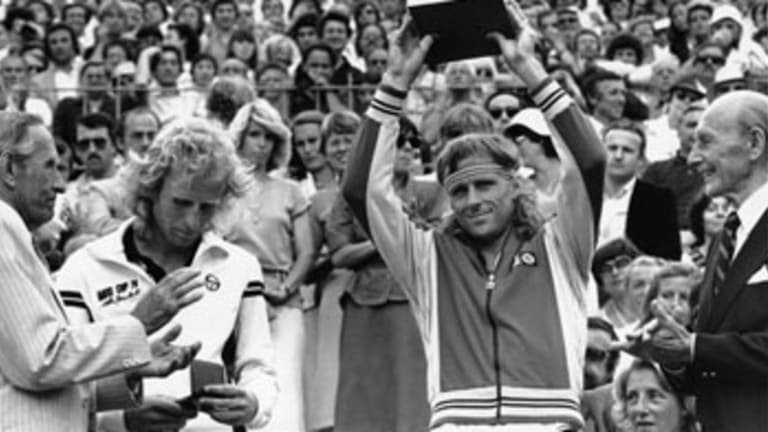Latest No Mas column below.
Also, as a final column for the clay season, here's one I wrote at ESPN.com last week.
On to the lawns.
“Steve, with Rafael Nadal now winning three straight French Opens, who is he still chasing? In other words, who's the greatest modern clay-court player the men’s side?”
This is one of those sports parlor games that’s really not much fun. It’s too easy—there is, and never has been, any argument. The answer is Bjorn Borg.
First, he’s got stats. Borg is the king of jaw-dropping numbers, especially on clay. Let's start with the fact that he played the French Open eight times and won it six times. And those two losses were to the same guy, Adriano Panatta (one came in Borg’s rookie year, when he was 17). Beyond that, Borg won two of those titles (1978 and ’80) without dropping a set; in 1975 he lost one set, and in 1981 he didn’t lose a set until the final. Nadal recently won 81 straight matches on clay, a perhaps-unbreakable record; but just you know, between 1977 and ’80 Borg went 95-3 on clay, and two of those losses were by default.
Back to the French Open, the true measure of greatness on clay. Borg didn’t just win this tournament. He made it look sick. Here’s how the 1978 draw went for him:
1st round: d. Deblicker 6-1, 6-1, 6-1
2nd round: d. Fagel 6-0, 6-1, 6-0
3rd round: d. Bertolucci 6-0, 6-2, 6-2
4th round: d. Tanner 6-2, 6-4, 7-6
quarterfinals: d. Ramirez 6-3, 6-3, 6-0
semifinals: d. Barazutti 6-0, 6-1, 6-0
final: d. Vilas 6-1, 6-1, 6-3
I’m going to assume that 32 is the fewest number of games ever given up by a Grand Slam winner. Also, notice who Borg beat in the final. Guillermo Vilas had won the tournament the year before (Borg didn’t play) and had set a clay-court winning streak record the same year (the one Nadal broke in 2006). But during that streak Vilas never played Borg, and it looks like the Swede wanted to show the world he was and always would be the undisputed master of dirt. According to one writer, after the two came out and played an extremely long first point, in which Vilas eventually dumped a forehand in the net, you could see by the Argentine’s body language that it was over right there. Another of Borg’s French Open victims of that era, Terry Moor, was behind 6-0, 6-0, 5-0 before he won a game. He wasn’t sure if Borg had given it to him—who could tell what the guy was thinking?—but Moor came off the court in disbelief that anyone could ever remotely challenge the Swede on any surface.
Borg was the best on clay because he was fast—those long legs were his signature, helped by the short shorts of the day—he had infinite patience, and he didn’t miss (a lethal combination, wouldn’t you say?). He roamed far behind the baseline, but still covered every inch of the court and managed to control the points with his topspin and casual accuracy. Few players at the time hit with that kind of spin and depth, and he used it to back his opponents up without having to hit a risky shot to do it.
If the Borg of 1978 walked on court today with his old wooden Donnay and Diadoras and demanded a showdown with Nadal, could he win? No. The Spaniard, his biceps, and his Babolat have too much power; he can go from defense to stinging offense in the blink of an eye. Watching clips of Borg and his rivals of the 70s, I’m always struck by the way they didn’t go for the lines with nearly as much abandon as today’s players do. Blatant winners from the baseline, such as Nadal hits every game, were comparatively rare. That’s a product of all the usual suspects—bigger racquet heads, the switch toward more Western grips, and the evolution of the inside-out forehand being the biggest of them. Still, I don't think Borg/Donnay-Nadal/Babolat would be a ridiculous imaginary mismatch, simply because of Borg’s ability to cover the court. This doesn't mean that Nadal, despite his three Roland Garros titles and winning streak, has risen to Borg’s stature on clay. As Nadal says, “Six [French Opens] is a long way.”
There is, or was, a YouTube clip of Borg’s final point at Roland Garros, when he beat Ivan Lendl in the 1981 final (of course he went out on top). He walks off laconically, like you would expect from a guy who had already done this five times before. Borg holds up the trophy and the French crowd gives a cheer unlike any other I’ve heard. It sounds to me like they’re happy he won because Bjorn Borg winning the French Open means that, no matter what else is happening in the world, all is right for this day. What was supposed to happen, did happen. You’ve got to be a pretty dominant athlete to make people react like that.
Keep the nose to the grindstone, Rafa.
